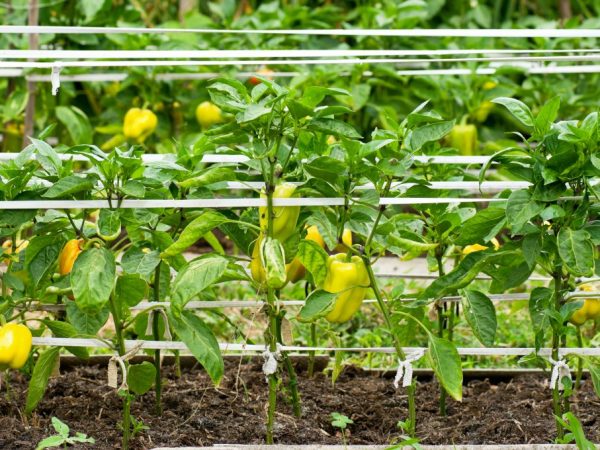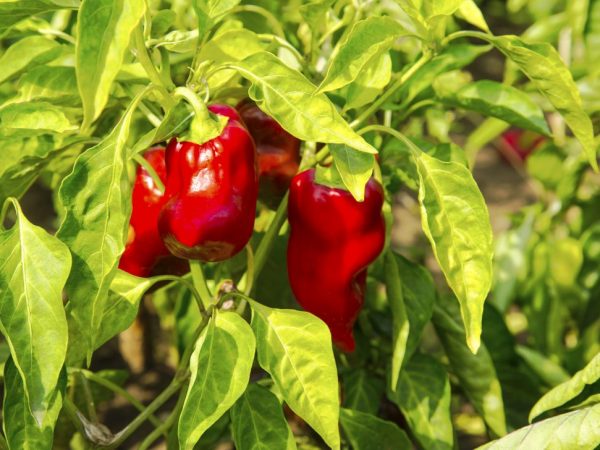Formation of pepper bushes
Shaping plants has specific goals. The formation of the pepper has a beneficial effect on its yield.

Formation of pepper bushes
In our climate, many thermophilic crops cannot cope with the amount of fruits that begin to ripen on them. In such cases, the formation of bushes, including pepper, helps.
The need to form a bush
Varieties of sweet pepper, depending on the estimated height of the bush, are divided into the following types:
- undersized (up to half a meter);
- medium-sized (up to one meter);
- tall (up to two meters).
Tall
It is imperative to carry out the formation of tall varieties of peppers. If you ignore this type of bush care, it can lead to a significant decrease in yield.
Medium-sized
You can form medium-sized sweet peppers as follows. It is worth removing only the sterile, as well as the lower shoots. This will relieve him of unnecessary stress, and will also contribute to better illumination and ventilation.
Undersized
Forming a small sweet pepper bush is not required. The same applies to the bitter type of vegetable. Such plants produce good harvests even without shaping them. The formation of a pepper bush in this case is necessary if it grows in greenhouse conditions, and a very dense planting scheme was used.
If the distance between the peppers is too small, the sun does not illuminate them enough. Small bushes of bell peppers or hot peppers can even be grown on a windowsill. In such conditions, you can also keep seedlings.
When you can and when you can not form a bush
It is possible to form a pepper bush only if it does not have diseases. You must use clean tools, otherwise there is a risk of contamination of healthy bushes with pathogens transferred from sick peppers.
Bushes must be tied up throughout the season. The scheme for the formation of a pepper bush involves several stages. Let's consider them in more detail.
Removing the crown bud
Pepper seedlings consist of one stem. However, when it grows to a length of about 20 cm, it begins to branch out. In the place where the branches are formed, the first flower begins to form. They used to call it the crown bud. This flower must be removed immediately. This will ensure proper branching and will also help to improve the nutrition of the ovaries that are located above the fork.
Cutting off excess

We remove unnecessary
Formation of tall varieties of pepper continues when 10 to 12 leaves grow on them. At this point, you need to delete the extra branches. A couple of shoots should be left that grow from the fork of the crown flower. The rest, less viable branches, should be shortened by cutting off the top.
The remaining branches, called skeletal branches, will form the basis of an adult sweet pepper bush.They will soon also begin to branch out like the main stem and form a fork with a bud in the center. These branches should be treated in a similar way - leave one strong shoot, and pinch off the others above the first leaf. The same procedure must be carried out with all the ramifications that will appear.
On all the branches, buds will appear, and then ovaries. They must be left behind. And those that grow in internodes must be removed. In total, it is optimal to leave from 15 to 25 ovaries.
Removal of sterile shoots
The plant continues its development after the extra shoots have been removed. This process should be monitored as empty shoots will appear over time. They will grow just below the branching point of the main stem.
It is recommended to pinch the shoots in dry weather. This will dry out the injured areas faster and reduce the risk of pathogens getting there.
You should also pick off the leaves that interfere with the lighting and do not take part in the nutrition of the ovaries. It is necessary to get rid of damaged leaves, as they can provoke the development of diseases.
To form a bush correctly, you must be guided by the following guidelines for pruning leaves:
- When the fruits of the lower cluster reach technical ripeness, it is necessary to immediately remove the leaves on the main stem. Cut off two leaves at a time.
- Then you need to wait until the fruits of the next brush appear. After that, continue trimming the leaves.
- Do the same with other leaves under growing fruits. The last time the procedure should be carried out about a month and a half before harvesting, since during this period the plant will need rest.
Removing the leaves in accordance with the recommendations will not only help to form the pepper correctly, but will also have a beneficial effect on the health of the plant.
Plucked leaves and shoots are not recommended to be left in the garden. They need to be removed from the site and disposed of, otherwise they can attract pests.
Pinching the kidneys
To form the plant correctly, you should start this stage after the fruits have grown in sufficient quantity. To accelerate their growth, you need to pinch the tops on the main branches. After this procedure, sweet pepper stops growing and begins to waste energy only on those ovaries that have already appeared. It is also necessary to form the pepper using this process one and a half months before the fruits are fully ripe.
Conclusion
Following the above rules is an important part of plant care. Of course, this takes a lot of time and effort. However, it is worth it as it will help form healthy pepper bushes and also increase their yield.
You need to understand that there is no single correct scheme. You can form both two and four shoots. And in which case the yield will be higher, only practice will show.


